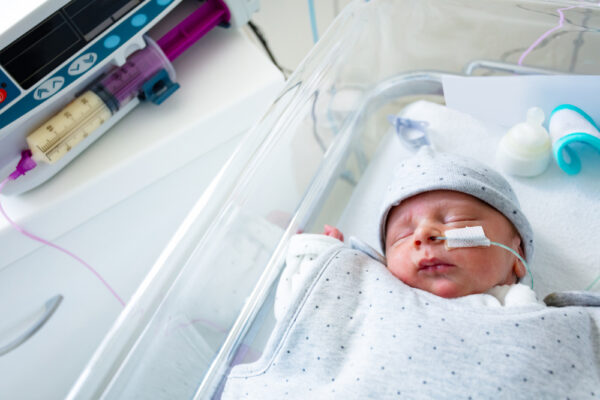During the last fifteen years of hospital care in the United States we have seen the proliferation of patient-controlled analgesics (PCA) given to post-operative patients. PCA is the delivery of intravenous narcotic pain medication through an electronic pump that can provide a continuous drip of narcotic with additional boluses that the patient delivers at will by pushing a button. The pumps are programmable to determine the rate of continuous infusion (basal rate), the amount drug to be delivered at the patients will (bolus dose) and the minimum time between each bolus dose (lock-out interval).
The usual drug of choice with PCA is Morphine. Other narcotics commonly used are Meperidine (Demerol), Fentanyl, Hydrocodone, Hydromorphone, Levorphanol, Methadone (Dilaudid), Oxycodone and Tramadol. The purpose of PCA is to provide the patient with some ability to maintain a reduction of pain to a tolerable level. When it is administered appropriately, PCA reduces the agitation and stress associated with inadequate post-operative pain relief. However, when nurses do not follow generally accepted standards, hospitals and their nurse-employees become liable for catastrophic injury and/or wrongful death. There are two major safety issues with patient-controlled analgesics (PCA):
- Traumatic injury from falling due to narcotic-induced alterations in mental status
- Narcotic overdose leading to brain damage or death
Preventing Traumatic Injury from Falling
The use of PCA with Morphine and/or other narcotics is so common on orthopedic and other surgical floors that the idea of instituting fall precautions with patients under the influence of narcotics is often overlooked. There is some controversy among experts as to what precautions are reasonable to prevent narcotic-sedated patients from falling and sustaining traumatic injury. One side of the argument is that once an assessment is made that the patient is alert and oriented to person, time and place and not exhibiting dizziness or excessive drowsiness, then it is reasonable to leave the patient alone while out of bed.On the other hand, the unattended out-of-bed patient with the ability to self-administer a bolus of 1 mg of Morphine every ten minutes can suddenly become overly sedated and lose the mental alertness needed to exercise the amount of caution required to avoid accidental falls. Therefore, even if a nurse documents that the patient was alert, fully oriented, able to follow instructions for safety and had the call bell in reach; there remains the possibility of a sudden change in mental status whenever the patient pushes the PCA button as the additional dosages of Morphine or other narcotic accumulate within the body. Consequently, there are certain safety protocols that must be in place:
- Side rails must be in the up position and the call bell in reach while the patient is in bed
- The patient must be under close observation while out of bed in a regular bedside chair with the call bell in reach at all times
- If hip precautions are being maintained and the patient must sit in a hip chair, one-to-one observation must be maintained for safety
- The patient must have someone within arm’s length while out of bed ambulating
The divergence in protocol between a standard bedside chair and hip chair exists because of the difference in the center of gravity. In a bedside chair, the center of gravity is at the buttocks, so the patient is less likely to fall out on to the floor with the onset of lethargy or loss of consciousness. However, with a hip chair, since the seat is higher at a slight downward angle, the center of gravity is at the torso. Thus, with a sudden onset of narcotic stupor, the patient is likely to fall forward onto the floor sustaining a hip dislocation and/or femoral fracture with the possibility of head injury. There are two opposing forces at work with post-operative management of the patient with hip replacement surgery. The orthopedic surgeons have moved from keeping such patients in bed for three weeks to taking them out of bed on the second post-operative day and placing them in a hip chair. This change in medical practice is beneficial in that it has reduced the incidence of pneumonia and lower extremity blood clots. However, since most of these patients are on PCA with Morphine or other narcotics, we are left with the problem of fall prevention with people who are at all times subject to sudden onset of narcotic stupor. This problem is compounded by the fact that the patient decides when to push the button. Therefore, although providing a one-to-one attendant for such patients while walking or sitting in a hip chair is a logistic problem, the hospital and nursing staff owe a duty to maintain the standard of safety knowing that there is a potential for falling because the current mental status (even if it is alert and oriented) can deteriorate suddenly and unpredictably with the self-administration of the next bolus of narcotic.
The Prevention of Narcotic Overdose
Public Misinformation: The health care service and product providers are misinforming the public in telling them that PCA is safe. After searching the internet with the key words “patient controlled analgesia overdose", I found hundreds of web sites from health service and product providers related to PCA. The repetitive message is that it is completely safe. Here are two excerpts of the public information on PCA with a brief analysis of each as to why the information provided is misleading:
Women’s Hospital University of Manitoba (PCA Information for post-operative adult females)
- Is it safe? PCA pumps have been in use for many years now and they incorporate a number of safety features. If used sensibly, they are very safe.
- What are the side effects? The main side effect is the same one you might experience after repeated injections of pain killers from the nurse. This is drowsiness, but it is usually much less intense.
- Can I overdose myself? Provided you only press the button WHEN YOU FEEL PAIN it is virtually impossible to overdose yourself.
- Does using the PCA pump mean that the nurses will pay less attention to me? On the contrary, the nurses will have more time to monitor your condition while you are on the pump, and attend to your other needs.
Analysis by the numbers:
- The term "very safe" is misleading because in the absence of any warnings, the reader is likely to believe that there is nothing to worry about.
- The brochure only mentions "drowsiness" as the main side effect. This implies that there are no other adverse reactions like, nausea and vomiting, reduced heart rate, lowered blood pressure, depressed respirations and death.
- This answer states that overdose is impossible as long as the patient pushes the button only when feeling pain. This statement is false. There is no guarantee against overdose because of possible machine malfunction and likelihood of human error in mixing the drug solution and programming the pump.
- The answer to the question about nursing implies a guarantee that the nurses are always available to monitor the patient’s condition at this hospital.
Genesis Health System (Iowa) (Information about post-operative PCA for children)
- How safe is the PCA? It is very safe. The machine has a computer in it that is set so too much medicine cannot be given. The machine has a "lockout" period that also prevents your child from getting a dose of medicine too soon. He cannot push the button too many times or get an overdose of medicine. He just pushes the button whenever he feels pain. Your child's caregiver will watch him closely for signs of sleepiness (too much pain medicine) or pain (not enough pain medicine).
- Are there any side effects? Your child may feel some side effects of any pain medicine, such as nausea (upset stomach), itchy skin, or trouble urinating. Caregivers will watch your child closely and work with him to prevent or treat these problems.
Analysis by the numbers:
- The PCA is initially described as “Very safe". There is then the reassurance that the child’s care giver will “watch him closely" for signs of too much medication. This is misleading because the parent is not likely to understand that the safety of the PCA programs is dependent upon how closely the children are being watched by the nurses.
- The instruction about side effects failed to mention the possibility of respiratory depression and death. The parents have a right to know that there can be a sudden onset of respiratory depression from the cumulative effects of multiple infusions of narcotic.
In summary, many health care institutions and product vendors appear to be misleading the patients and their loved ones to believing that PCA is completely safe, with no chance of overdose while the only side effect is drowsiness, itching, nausea or difficulty urinating. In these cases, the patients’ family members and significant others are being robbed of the opportunity to avoid accidental overdose by making certain that the nurses are programming the pumps correctly and that the patient is being watched for signs of respiratory depression and excessive drowsiness. If the patients’ loved ones are informed about the cumulative effects of additional doses of narcotics and the possibility of respiratory depression, there would be a significant improvement in the response time of nurses and doctors to symptoms of narcotic overdose. There should be enough information given to raise consciousness without causing inordinate fear. It all comes down to the health care provider’s choice of words.
The Common Causes of Accidental Narcotic Overdose with PCA
The Institute for Safe Medication Practices (ISMP) published a list of common causes of narcotic overdose with PCA that it provided to the FDAs Center for Devices and Radiological Health (Medication Safety Alert; July 10, 2003):
- PCA by proxy a designated third party pushes button for a child or mentally incompetent adult
- Improper patient selection people without the capacity to exercise reasonable judgment
- Inadequate monitoring nurses failing to monitor with adequate frequency and employing faulty monitoring techniques
- Inadequate patient education failing to give proper instruction or assuming that the patients are able to listen to and follow when, in fact they are not
- Administering the wrong drug
- Malpractice misprogramming the pump or making dosage calculation errors
- Product liability. The ISMP identified the Abbot Life Care PCA II and APM infusers as having design flaws that makes it easy to deliver an infusion rate of 1 mg/ml of Morphine in lieu of 0.1 mg/ml a general design flaw of all pumps is that the infusion button looks like the nurses call button, so that the patient can easily infuse an additional dose of narcotic while attempting to call the nurse to report an adverse reaction
- Inadequate staff training nurses are not being taught how to program and monitor the pumps in a way that would decrease the risk of human error
- Prescription errors physicians often miscalculate the appropriate dosage for the patient
The Standards of Nursing Practice for Avoiding Accidental Narcotic Overdose with PCA
First, it is important to note that not all incidences of fatal or brain damaging narcotic depression are the result of negligence. When it comes to medical judgment, physicians have a great deal of leeway in prescribing. There is a medical and nursing standard that requires periodic pain assessment and action to control pain. One unfortunate result of this standard is that doctors often throw caution to the wind in exchange for achieving adequate pain relief. Nonetheless, the standards of care require that a care plan be implemented with certain nursing actions as follows:
- Adequate in-service training in the use of PCA pumps
- Assessment of mental status
- Adequate teaching of patient and family members
- Maintaining a PCA patient care flow sheet
- Monitoring Arousability, Color of Skin and Nail Beds, Vital Signs, Blood Pressure and Oxygen Saturation
- Review the doctor’s order for appropriateness of dosage and compatibility of the medication.
Adequate In-Service Training in the Use of PCA Pumps
The nurses must receiving instructions on how to operate and program the device being used. The dangers of misprogramming and other known design flaws that increase the risk of overdose must be a part of the curriculum. The nursing management has an obligation to provide such instruction and each nurse owes a professional duty to attend such classes or demand them if none are being offered.
Assessment of Mental Status
The nurses owe a duty to assess the PCA patient for ability to hear, listen to, understand and follow instructions. The patient must be able to understand that the more he or she pushes the button the greater the risk of harmful narcotic depression. If the patient is deemed not physically and/or mentally capable of operating the PCA, it is permissible to administer it by proxy (a responsible family member pushes the button for the patient). However, the patient has to be able to articulate the presence and intensity of pain.
Adequate Teaching of Patient and Family Members
After assessing the mental status, the nurses must explain all aspects of PCA operation so that patient knows that a push of the button infuses a particular dosage of the narcotic and that dosage is preprogrammed by the nurse. The patient and significant other(s) should also be shown where the cumulative dosage appears on the digital display so that they can keep an eye on the total amount received. For example, some doctors allow their patients a maximum dose of 21 mg of Morphine over three hours. The patient and loved ones need to be able to also observe the digital display to guard against exceeding the maximum allowable dose per hour.
Maintaining a PCA Patient Care Flow Sheet
Every hospital is required to provide the nursing staff with a PCA patient care flow sheet. This tool serves as a reminder of what assessments must be made and when.
Monitoring arousability, color of skin and nail beds, vital signs, blood pressure and oxygen saturation
The nurses must check for arousability, signs of cyanosis in skin and nail beds, heart rate, respiratory rate, blood pressure and oxygen saturation as follows:
- Every fifteen minutes for the first hour
- Every half hour for the next hour
- Again in one hour
- Every four hours thereafter
The nurse must also check the patients respiratory rate, skin and nail bed color and oxygen saturation every hour between assessments.
Review the doctors’ order for compatibility of the medication and appropriateness of dosage
The nurse must review the order to make certain there is no history of adverse reaction to that particular drug. If there a history of such reaction, the nurse is required to question the order refuse to carry it out and prevent others from doing so. The maximum allowable dosage must also be reviewed to determine the risk of over-medicating the patient. Although doctors have wide discretion there are guidelines for maximum dosage per kilogram of body weight for children and age groups for adults published by the drug manufacturers that the physicians must follow. The nurse here too must question the order, refuse to carry it out and prevent others from doing so if it exceeds the maximum recommended dosage.
Tom Sharon is a nursing and patient-safety expert and author of With Liberty and Coverage for All: who shall live, who shall die, and how to survive under Obamacare – a complete update on hospital mistakes and the Patient Protection and Affordable Care Act of 2010.













Comments for this article are closed.